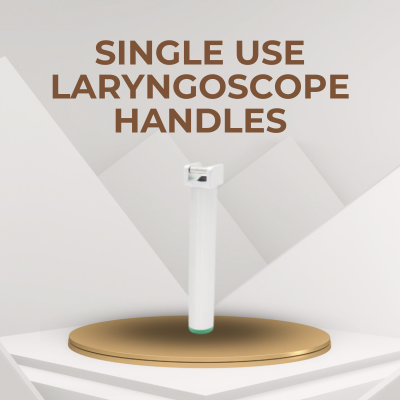In the fast-paced and ever-evolving world of healthcare, adopting innovative and efficient solutions can significantly enhance patient care and safety. One such advancement in medical equipment is the shift from reusable to single-use laryngoscope handles. Laryngoscopes are essential tools used in medical practices, particularly in airway management during procedures like intubation. While reusable laryngoscope handles have been the standard for years, single-use options are gaining popularity due to several compelling benefits that improve infection control, convenience, and overall patient outcomes.
In this article, we’ll explore why switching to single-use laryngoscope handles is a smart choice for medical practices, from infection prevention to cost-efficiency and enhanced reliability.
1. Enhanced Infection Control:
Infection prevention is a top priority in healthcare settings, especially in environments where invasive procedures like intubation are performed. Although reusable laryngoscope handles are carefully sterilized after each use, they pose a potential risk of cross-contamination. Despite rigorous cleaning and disinfection protocols, traces of biological material can still linger in hard-to-reach areas, increasing the risk of hospital-acquired infections (HAIs).
Single-use laryngoscope handles eliminate this risk. Using a new, sterile handle for each patient minimises the likelihood of cross-contamination, ensuring a higher standard of infection control. This is particularly crucial in high-risk environments like intensive care units (ICUs), operating rooms, and emergency departments where patients may already have compromised immune systems.
2. Improved Patient Safety:
The safety of patients should always be the foremost concern in medical practice. When healthcare professionals use single-use laryngoscope handles, they can have greater confidence that the device is clean, free of contaminants, and functioning optimally. Unlike reusable handles, which may be prone to wear and tear over time, single-use laryngoscope handles are guaranteed pristine for every procedure. This reduces the risk of device failure during critical moments, which can significantly impact patient outcomes.
Additionally, single-use handles are manufactured to precise specifications, ensuring consistent quality and performance. This reliability is vital when managing a patient's airway, as a malfunctioning or poorly maintained device could lead to complications or delays in securing the airway.
3. Time and Labor Efficiency:
Cleaning, sterilizing, and maintaining reusable laryngoscope handles can be time-consuming and resource-intensive. In busy medical environments, staff must ensure that handles are adequately disinfected and stored for future use, wasting valuable time and workforce that could be directed elsewhere.
By switching to single-use laryngoscope handles, medical practices can streamline their workflow. There’s no need for disinfection protocols or the risk of human error in the cleaning process. Once a handle is used, it is disposed of, and a new, sterile one is ready for the next patient. This improves the overall efficiency of medical staff, allowing them to focus on patient care rather than device maintenance.
4. Cost-Effectiveness in the Long Run:
While single-use laryngoscope handles may seem more expensive upfront, they can be more cost-effective in the long term. The hidden costs associated with cleaning, sterilizing, and maintaining reusable laryngoscope handles can add up quickly. Medical practices must account for the labour, equipment, and time required to sterilize handles, and these costs can soon overshadow the initial purchase price of disposable handles.
Single-use handles eliminate these ongoing costs. Medical practices can achieve significant savings over time by removing the need for sterilization equipment and labour. Additionally, practices no longer need to purchase replacement parts for reusable handles or deal with unexpected breakdowns, making single-use laryngoscope handles a cost-effective solution in the long run.
5. Convenience and Reduced Risk of Misplaced Equipment:
One practical advantage of single-use laryngoscope handles is their convenience. In busy medical environments, reusable equipment may get misplaced or mixed up with other instruments, potentially causing patient care delays or compromising patient safety. Since single-use handles are disposed of after use, there is less chance of equipment being lost, misplaced, or contaminated between uses.
This convenience also extends to inventory management. Single-use laryngoscope handles are often packaged individually, making it easy to keep track of stock levels and ensuring that sterile instruments are always readily available when needed.
6. Environmental Considerations and Sustainability:
In recent years, there has been increasing awareness of the environmental impact of medical waste. While disposable items in healthcare are often associated with environmental concerns, advancements in material science have made it possible to produce single-use laryngoscope handles with recyclable or biodegradable materials. Practices can choose products that meet sustainability standards, helping to reduce their environmental footprint without sacrificing performance or safety.
This is a key benefit for medical practices committed to sustainability. By choosing eco-friendly single-use options, healthcare providers can contribute to a cleaner, greener environment while maintaining high standards of patient care.
7. Compliance with Regulatory Standards:
With the rising importance of infection control and patient safety, healthcare facilities must comply with stringent regulatory standards set by governing bodies like the U.S. Food and Drug Administration (FDA) and the Centers for Disease Control and Prevention (CDC). Single-use laryngoscope handles are often designed to meet or exceed these regulatory requirements, offering healthcare providers peace of mind that their practice is adhering to the latest safety and infection prevention guidelines.
Additionally, single-use devices are typically subject to rigorous testing and quality control processes before they reach the market. This ensures that the handles meet the highest standards for performance and safety, which can be crucial during critical procedures.
Conclusion:
Switching to single-use laryngoscope handles offers numerous benefits for medical practices. From enhancing infection control and patient safety to improving time and labour efficiency, these handles provide a reliable and cost-effective solution for managing patient airways. The convenience of disposable handles, their potential for cost savings, and improved compliance with safety standards make them an appealing choice for modern medical practices.
While there may be initial concerns regarding cost and environmental impact, the long-term advantages—such as improved safety, infection prevention, and operational efficiency—outweigh these considerations. By embracing single-use laryngoscope handles, medical practices can ensure a higher level of patient care while streamlining operations and meeting the ever-growing demands of the healthcare industry.
For Further Information Visit: Best Surgical Supply Store





Comments